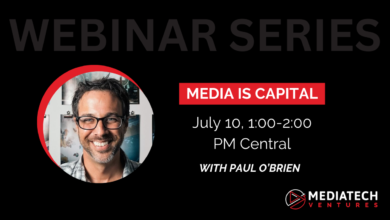
While it was discovered decades ago that only two things create value in business, it dawned on me only yesterday that a tenet of Marketing is broadly applicable to your work as artists, creatives, media professionals, and entrepreneurs.
In 2008, Dartmouth College’s Frederick E. Webster Jr. published in The Journal of the Academy of Marketing Science, a study in the notion that Marketing is Management. Drawing from the earlier work of Peter Drucker, the economist who noted that only two things create value, Webster noted that the primary value of a [corporate] culture is an orientation to the customer. That is, be that the culture of your startup, your production, or inherent in what you create as an artist, the underlying culture impacts how a customer will engage with what you’re doing (i.e. how and if they’ll pay).
Webster further asserts that Marketing is a core discipline of the business (Marketing IS Business)
The 4 Ps of Marketing
Drucker’s earlier work noted that the two things that create value in business are marketing and innovation – or as we think of it: Media and Technology. And it’s in weaving the work of Drucker and Webster with these notions of media and technology creating the value in whatever it is that you’re doing, that I wanted to foundation of Marketing (the 4 Ps) and translate them to the 4 Ps of Media Technology.
Product, Price, Place, and Promotion
The four Ps, popularized by Neil Borden in the 1950s, are the key factors that are involved in developing a good or service. Before the internet complicated our understanding of the relationships between your work and your customers, Borden’s marketing mix, as it’s called, helped businesses account for the barriers that hinder adoption.
Product
Product refers to WHAT you offer customers. While, in media, a manifestation of your ideas or creative works, that product is likely only to make money if it fills a certain consumer demand or is so compelling that consumers believe they need to have it. To be successful (in having something your audience pays for), understand the life cycle of a product and have a plan plan for dealing with products at every stage of their life cycles – that is, when new to the world your product might appeal to some, through specific channels, while after it has matured in the market, you may need to look to other audiences and ways to promote the appeal.
As such, appreciate that the type of product also partially dictates how you can charge for it, where it should be available, and how to promote it. Consider as an example, that your brand new video game might compelling and more valued exclusively on Playstation for now, later available through PC and Xbox, and ultimately making money through Steam or Google’s Project Stream.
Price
All too often, artists and creative set prices based on their perceived value of a deliverable or the hours spent to produce something. Challenging us even more in media, streaming services such as Spotify and Pandora, design marketplaces, new AIs that create content, and more, disrupt how customers perceive the value of our work. Still, when thinking about price, a marketer needs we must consider the customer’s perception of what you offer and their point of view on what it’s worth.
Price too high relative to their perception and you won’t sell. Price too low relative to that perception and in the best case, you’ll leave money on the table; more often than not, you’ll actually destroy the value in your brand by establishing that your work is available for LESS than what customers think it worth. Under valuing what the market will bear and you risk going out of business. Expecting too much of customers and they’ll find ways to get what they want, without appreciating your work.
Price is the cost consumers pay. Whether you perceive yourself as an artist or producer, you are a business, and you must consider supply costs, discounts, your time spent, and competitors’ prices, in setting a price or you will under value your work.
Place
Place is the concept translated from the 4 Ps of Marketing to the 4 Ps of Media Technology on which I really wanted to spend a moment.
Where your video / your game / your service / your music / your design, or what have you, is available. Your goal? Get your brand and what it has to offer in front of everyone likely to buy.
Yet in media, for some inexplicable reason (since we should know better than any business), many of us seem content to only have a website (or worse, use a site provided by a third party), or only sign with a label, only stream on Netflix, only be available on iOS, or only promote through Facebook.
With the dawn of the internet, it is no longer sufficient that you PLACE your product or service in one, or even a few, “channels.”
Channels are the ways that you are available for use by the consumers.
Spotify and Netflix are distinct channels, so too is the Google Play store, promoting yourself on Instagram, or streaming via Twitch
Being Omnichannel
Being Multichannel is absolutely essential. The more channels you employ, the better the odds of people finding and buying from you; your customer has their own preferred method of contacting businesses.
However, being available in distinct channels fails to appreciate that today’s online world consumes content in so many different ways that their likelihood to buy from you is influenced by distinct experiences within more than one. This is called being Omnichannel, and thanks to the internet, and tools readily available to you like CRM and Marketing Automation, it’s not unreasonable to expect that your work is available Omnichannel.
Nick Campanella and GETCRM put together a great infographic and piece explaining the difference between being multichannel and being omnichannel.

“Omnichannel marketing uses all those same channels, but in a way that best fits the customer’s needs.”
When visitors book a trip online, they can use Disney’s website to plan out their daily schedules, use the app to access park information, or even discover new attractions. All of this also connects to their Magic Band program, which allows users to load all of their park tickets, fast pass, and even money to purchase food or souvenirs into a “magic band” that visitors actually wear around their wrists throughout the day. The app, in turn, can also track everything on the band.
The point being, whether you’re a band, a startup, or a designer, PLACE now means everywhere; and in media, there is little reason not to be so.
Promotion
Promotion includes advertising, public relations and promotional strategy. Yeah, I know, blows your mind to hear that Marketing doesn’t mean Advertising; advertising is one thing marketing doesn’t having determined if you must. Promotion of your product in various places is what shows consumers why they need it and should pay a certain price for it.
You know as well as I that how you approach “place” and “promotion” today is important offline as much as on, and that “digital” is only half the battle. What few consider though is WHY Webster explored the notion that Marketing IS Business: Promotion is a cost.
Peter Drucker, decades before Webster’s study, noted that “The aim of marketing is to make selling superfluous,” — The Product people want, available in the Place they expect to find it, at the Price they value, is a business that grows organically. Promotion (or needing to promote/sell) is required when what you’re doing falls short in another P.
Frederick Webster’s paper is really a worthwhile read if you’re as much of a marketing wonk as I tend to be.
- The importance of balancing a focus on short-term financial results and long-term viability.
- The importance of an organization’s ability to adapt to changing market conditions.
- The need for continuous innovation based on a deep understanding of customer needs.
- The requirement that businesses seek to create satisfied employees as a moral, social and financial obligation.
- A warning against the excessive use of sales promotional tactics.
Whether the 4 Ps of Marketing or our translation of them to MediaTech, there is much to be said for practiced fundamentals and conventional wisdom. The advice that came before us is just as valid as today. Marketing is the work of what you offer (product), where you offer it (place), determining the ideal cost to consumers (price), and communicating where your likely customer will discover it (promotion). That’s a business. Falling short in a P is why you’re struggling to succeed.







The 4Ps haven’t changed but th landscape has. How I wish I was young with th Marketing tools available today. But I was BBT. Born b4 technology. It’s so hard to keep up. It’s like learning a new language. I was never good at language. Though Reading ur blog makes me excited.
Thanks Helen! I absolutely believe the better part of our workforce development and income disparity could be addressed by simply getting everyone up to speed on the pace of change and the newer resources available.
In this coming era where we’ll really be reacting to Singularity, I’d add Process and Personnel.